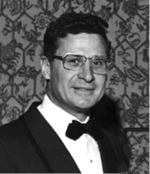
Alan Sargeson upon receipt of the American Chemical Society award in Inorganic Chemistry, 1980.
Alan McLeod Sargeson passed away on December 29, 2008, at the age of 78. Alan made highly fundamental contributions to the synthesis, mechanistic behavior, structure and stereochemistry of coordination compounds. In many ways, his work contributed to a “coming of age” for inorganic chemistry, as mechanistic pathways distinct from those in organic chemistry were established. The extensive list of his accomplishments, many of which we include here, comprise a number of phenomena which we take for granted today. Alan and his coworkers unequivocally established the conjugate base mechanism for base hydrolysis of Co(III) complexes through a series of elegant experiments, including competition of added anions. These were a beautiful complement to the classic 16OH2/18OH2 competition experiments of Green and Taube.[ Citation 1 ] He was one of the first inorganic chemists to appreciate the utility of NMR methods in coordination chemistry. His first NMR results led him to comprehend that coordinated chiral amines could be resolved, dispelling the notion that such compounds could not be resolved into their chiral forms. His most important research provided insight into the ways a metal can stabilize or destabilize organic molecules, and into how a metal center may be involved in mechanisms of enzyme action. Understanding gained from earlier mechanistic studies led to a broad exploration of the reactions of coordinated ligands, significantly aiding the development of novel methods for synthesis of complexes of amino acids, peptides, and their degradation. It became clear that a metal could act both as a protecting and activating group as well as a reaction inhibitor. The capstone of his work was the facile synthesis of a broad array of organic cages: sarcophagines and other novel macrocycles which encapsulate a range of transition metal ions. Over a decade-long period, experiments on these novel compounds explored accelerations of 105 in electron-transfer rates, remarkable kinetic stabilities of Zn(II) and Mn(II) complexes, biological activity and surfactant properties, and use as radioactive medicines/tracers.
Alan was born in Armidale, New South Wales (NSW), Australia on October 13, 1930. His family lived in a number of rural locations in NSW until he turned 15. Early stimulation in science came from teachers in rural Cootamundra, and in his last two years of high school in Maitland, near Sydney. He received a B.Sc. in 1952 from the University of Sydney, and completed his Ph.D. with Francis P. Dwyer at Sydney in 1956. His first permanent academic position was that of Lecturer at the University of Adelaide, 1956. In 1958, he joined Dwyer, who was setting up the Unit of Biological Inorganic Chemistry (note that this greatly predates any use of the term bioinorganic chemistry abroad) in the John Curtin School of Medical Research at the Australian National University in Canberra. After Dwyer's unexpected death in 1962, Alan spent a short postdoctoral leave with Henry Taube, and returned to lead the Unit of Biological Inorganic Chemistry, where he and David Buckingham began a productive collaboration. The group moved across campus to the newly-founded Research School of Chemistry in 1967. He became Professor in 1978, retired in 1996, and continued to publish throughout his retirement, with a list of publications totaling nearly 400. Alan was the recipient of a large number of national and international awards and honors, including the ACS Award in Inorganic Chemistry, the Bailar, Nyholm, Dwyer and Centenary medals, and learned society memberships, to mention a few: Fellow of the Royal Australian Chemical Institute, Fellow of the Royal Society, and a Foreign Member of both the Royal Danish Academy of Sciences and Letters and the U.S. National Academy of Sciences.
On the personal side, Alan was a dedicated family man and is survived by his wife Marietta, children Kirsten, Frank, William, and Bente, and grandchildren Emily, Zhane, Oscar, Maryanne, Bronwyn, and George. Alan loved Australia, inspired admiration and respect for the nation in his foreign disciples, and resisted offers of positions in Europe and the United States. His interactions were pervaded by a dedicated informality which was spontaneously delightful and engaging. He had a sense of humor that immediately made younger coworkers part of a unique group, with a convivial atmosphere where lively discussions were interspersed with serious, exciting chemistry. Bruce remembers Alan's particular fondness for quoting the antics of the chemists in The Struggles of Albert Woods,[ Citation 2 ] to this day still bringing a smile and a chuckle. Alan's approach to chemistry was unique, very clever, and not duplicated in any other laboratory worldwide. He was clearly one of the most creative and insightful chemists of his generation. We will miss his friendship and his chemistry.
REFERENCES
- Green , M. and H. Taube . 1963 . Inorg. Chem. , 2 : 948 – 950 .
- Cooper , W. 1952 . The Struggles of Albert Woods , Jonathan Cape : London .